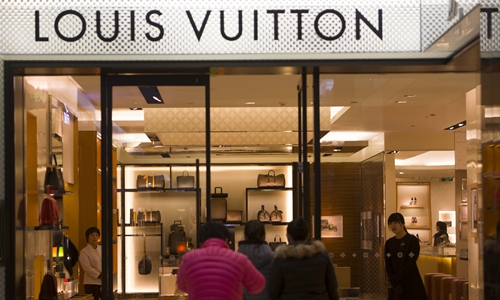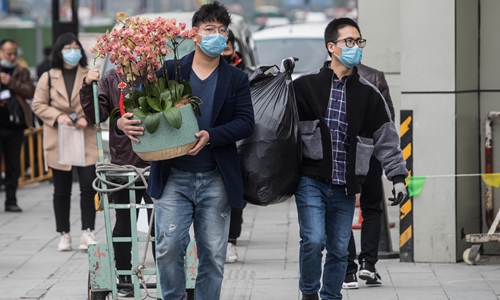HOME >> SOURCE
Weak data calls for stimulus
By Wang Cong Source:Global Times Published: 2020/3/2 23:48:40 Last Updated: 2020/3/3 0:09:17
Bold measures necessary to boost consumption: analysts

China is the world's top consumption market for luxury products and contributes over half of global sales. Photo: cnsphoto
Disappointing data on China's manufacturing sector released on Monday offered more ominous signs that the Chinese economy could be heading for one of its worst quarters since the global financial crisis in 2008 due to the ongoing coronavirus epidemic, as the data fueled increasing calls for more bold, targeted measures to boost the largest economic growth driver - consumption, to ease the hardship.With the epidemic continuing to batter the manufacturing sector, investment projects and other growth drivers, Chinese economists are calling for "special measures in special times," including cash coupons and extended consumer loans to ease purchasing restrictions in certain areas, to unleash the vast potential of Chinese consumers.
Though a full recovery from the epidemic in three main growth drivers - consumption, investment and export - might be deemed unrealistic, the underlying fundamentals of the Chinese economy still remain solid and there are plenty of policy tools China can deploy to ensure relatively stable economic growth for the rest of the year, analysts said.
On Monday, the Caixin/Markit manufacturing purchasing manager's index (PMI), a closely watched gauge of China's factory activity, plunged in February to 40.3, the lowest since 2004. The Caixin PMI, which tracks smaller private companies, was higher than the official manufacturing PMI's reading released on Saturday, which dropped to 35.7, its lowest level on record.
The data, among the first direct indicators of economic activity in China since the coronavirus outbreak set into motion nationwide strict anti-epidemic efforts, fueled speculation of China slipping into an economic crisis worse than the global financial crisis originating in the US in 2008. While such assessments might be overblown, forward-looking considerations for "special measures" might be necessary, analysts said.
"Up until now, we have been focusing solely on resuming production. That should still be the top priority for now and in the coming weeks. But we also have to think of all necessary measures to stabilize key growth drivers," Cao Heping, a professor of economics at Peking University in Beijing, told the Global Times, noting that consumption is not only the largest growth driver but is also "relatively easier" to improve.
In 2019, domestic consumption contributed to a whopping 89 percent of China's economic growth, of which 57.8 percent came from household final consumption expenditure, according to the National Bureau of Statistics.
In the wake of the epidemic, Chinese officials have also repeatedly cited an immediate, strong rebound in consumption after the epidemic is contained as one of the chief factors that will lift the economy. However, some analysts argued that some losses in consumption during the epidemic will not pick up automatically unless policy support is put into place.

People walk near the Sijiqing clothing wholesale market - the biggest one in China - in Hangzhou, East China's Zhejiang Province on Monday. The market resumed operations on Sunday with many measures taken including disinfecting every vehicle to provide a safe environment for customers amid the epidemic. Photo: IC
'Special measures'
"In some areas the losses will not be fully recovered. For example, people won't suddenly eat more food after the epidemic. But in other areas, if you put more money in consumers' pockets, then naturally they will spend more," Lu Zhenwang, founder of Shanghai Wanqing Commerce Consulting told the Global Times, adding that apart from monetary policies to ensure sufficient liquidity, banks could also increase loans for consumers.
More than just extra loans, some have even started floating the idea of handing out cash to consumers to spur spending. "Special times require special measures," Li Xunlei, chief economist at the Shanghai-based Qilu Asset Management, reportedly said last week, calling for "consumer coupons for all."
Other analysts have also called for extended holidays and relaxing restrictions on house and car purchases as measures to spur consumer spending. China Passenger Car Association (CPCA) said last week that propping up auto sales was the most effective way to stabilize consumption and there was still much room for growth if restrictive policies in some cities and certain types of cars were lifted.
"Measures on limiting car purchases are still relatively strict," the CPCA said in an article, arguing that lifting such restrictions, reducing sales taxes and promoting car sales in rural areas could help consumption.
Cao also said that even though cracking down on housing speculation has been a top priority in the past few years, "there are still some areas where genuine demand is high and certain restriction measures should be considered." He said that it will not only help boost consumption but also is in line with the central government's approach to adopting different policies based on realities in different regions.
All-round approach
However, boosting consumption will not address everything, as some small businesses in catering and other sectors will unlikely survive the impact, according to Liu Xuezhi, an economist at Bank of Communications, who called for a more comprehensive approach.
"Certainly, boosting consumption makes sense but we have to tackle this from both aspects of supply and demand and from all main growth drivers," Liu said, noting that more targeted support should be offered to help businesses, particularly small businesses, to get back on their feet. "This is not just about saving these businesses but also saving jobs."
Chinese officials have launched a series of measures, including 300 billion yuan in discount loans, significant cuts to taxes and administrative fees, reduced rents, labor and other costs, to help businesses across the country resume production.
At the end of last week, 40 percent of the Chinese economy resumed activity, up 5 percentage points from the previous week, according to a research note from China Merchants Bank on Monday.
"As soon as we resume full production, all the rest, including consumption, investment and trade, will pick up because the fundamentals in these areas have not changed," Cao said.
Among the three main growth drivers of the Chinese economy, export could see lasting challenges due to the spread of the virus throughout the world on top of already declining foreign demand. However, both investment and consumption will remain stable, Liu also noted. "Investment in particular will likely see a sharp increase because it has largely depended on macro policies," he said.
Posted in: ECONOMY